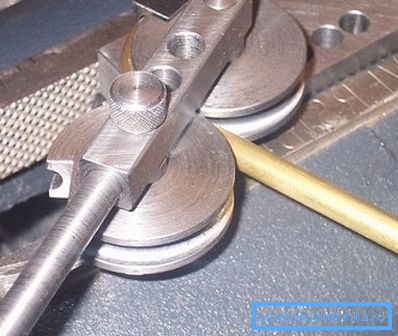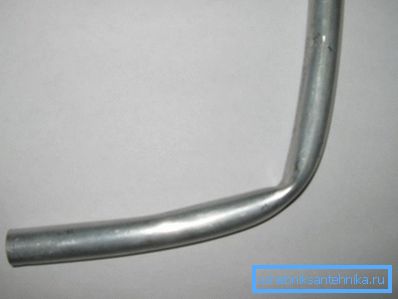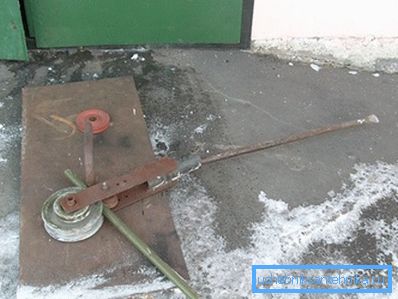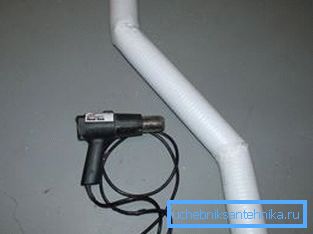Pipe bender for pipes at home
In the process of working with pipes, it is often necessary to lay the pipeline in hard-to-reach places where direct products alone are not enough. In such cases, there is a need for curvilinear and curved elements that are not available in hardware stores, and what about, you ask?
The easiest and most affordable way to solve a problem is to use a special tool - a pipe bender, which we will discuss in our article.

Pipe bending tool
Pipe bending devices can be:
- Hydraulic - The powerful pipe bender for steel pipes is able to cope with products of large diameter, often used in industrial facilities.
- Mechanical. This tool has an average power.
- Tame. They are used for products with a diameter of up to 50 mm and profiled with a cross section of up to 40 mm.
Note! Using the manual pipe bender for thin-walled pipes do not overdo it, as the products do not have high compressive strength and curvature. And we all know that even a small crack is a prohibition to use.

In addition, these tools also differ in the material from which the products to be bent are made:
- Hydraulic or mechanical pipe bender for stainless steel pipes.
- Manual pipe bender for metal pipes.
Note! A device for imparting different shapes to pipeline elements will not be suitable for profile rolled products.

At first glance, the simple process of bending products is actually quite complicated, so you need to perform it with extreme care to prevent the following defects:
- Crushing of the material, resulting in a narrowing of the internal diameter of the pipe and, accordingly, reduced permeability. And the formation of blockages in such places will lead to repairs and investments to restore the efficiency of the sewer system.
- Stretching and thinning of the pipe wall, which affects its strength, decreases the maximum allowable pressure.
Note! Properly selected tools for each case will allow you to qualitatively perform the bending of products according to the specified parameters. With such a tool you can optimize the laying of communications in the building, efficiently using the space of the premises and without damaging the performance of the pipeline.
Any pipe bender can be purchased in the building departments of supermarkets, having laid out a tidy sum for it, or you can make it yourself.
Tool for bending round pipes
The design of the pipe bender is quite simple - these are two machined pulleys:
- One of them is fixed permanently.
- The second rotates in orbit around the first one at a distance equal to the diameter of the pipe being bent.
The principle of operation of the device also does not cause difficulties - the product is laid between the pulleys and, by moving a free-rotating pulley, bends along a given radius.

Homemade tool
Making a homemade pipe bender for a round pipe, immediately take care of its versatility, that is, the possibility of bending products of different diameters.
Therefore, it will be necessary to prepare not a pair of pulleys, but three pairs, at least (at the very way of the pipe running on the farm):
- One pair for half an inch diameter.
- Another - on 3/4 pipe.
- The third calculated on inch diameter.
You cannot buy the necessary pulleys, so if you are not a professional turner, order them in the nearest workshop.
The nuances of milling the main parts of the pipe bender are as follows:
- For the manufacture of a pulley, the main thing is to observe the radius and depth of the groove.
- The ends of each pair of wheels should have a notch similar to half a pipe section.
- The ratio of the diameters of the parts is also important. The stationary pulley should be smaller, since the minimum radius of possible bending depends on it. The diameter of the second (rolling) to exceed the size fixed not less than twice.
Note! The price of turning works is low, so it will not greatly affect the final cost of the tool.
Next, the instruction of independent actions on the device of the pipe bending machine:
- The basis for the installation of pulleys can serve as a square, cut from thick-walled (at least 10 mm) sheet metal. It should immediately drill four holes for fastening on the worktop in the workshop. Or, weld the square to a dug-in and concreted column from a pipe with a diameter of 100-150 mm.
- In the center of the plate we weld a pin with a diameter equal to the inner diameter of the smaller pulley. The second vertical will serve as a stopper for the bent product.
- The next stage is the creation of a turning mechanism. From a thick steel strip 50 mm wide, it is necessary to weld the letter P. The height of our P-ki should be equal to the sum of the diameter of the large moving circle and half of the fixed diameter. For their fasteners in P-ke we drill holes, the distance between the feet of P-ki should slightly exceed the thickness of the pulley.
- We weld a handle about 250 mm long to the top of this part. The pipe inserted into it will serve as a lever in the process of bending.

- We collect all the details. The small pulley is inserted inside the P-ki and is mounted on the frame together with it, we fix the large one with pins and our pipe bender is ready.
Tip! In order to avoid getting defects in the place of bending, secure yourself and fill the pipe with sand, and to facilitate the bending of thick-walled products with a large diameter - warm them.
Different ways of bending pipes
- The pipe bender for aluminum pipes as, actually, also the manual pipe bender for copper pipes can be several types:
- Lever.
- In the form of a crossbow.
- Hydraulic.
- Electric.

- An interesting option is a spring tube bender for copper pipes. It is a spring made of high-quality steel with a funnel-shaped extension on one side for easy dressing / lifting. The pipe is placed inside the spring, then bending is performed. The durable material of the spring at the same time does not allow the pipe to break and crush.
- A similar spring tube bender is also used for metal-plastic pipes, they differ in the applied forces.
- Plastic products are bent by heating at the bend - for this you can use a building dryer.

Conclusion
The need to use the above tool is indisputable in cases where the laying of the pipeline is impossible due to existing obstacles. It is also used for heating elements, for example, for a home-made towel dryer.
In the presented video in this article you will find additional information on this topic.